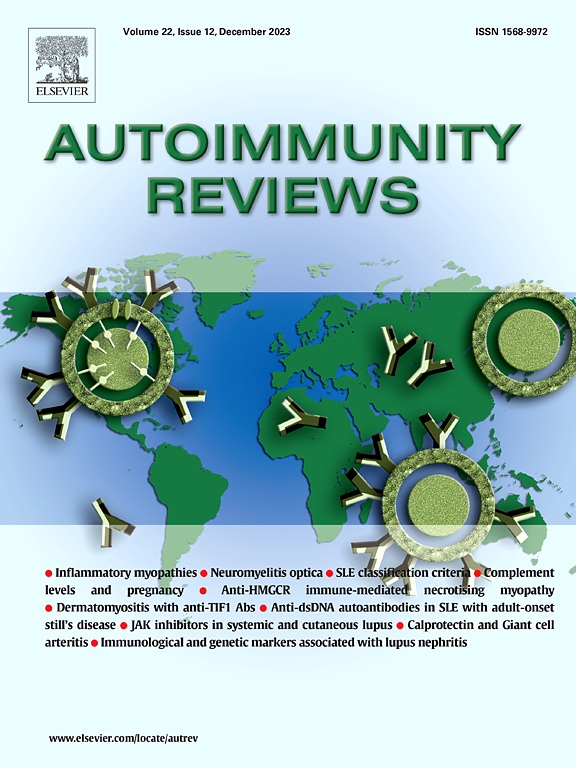Lupus nephritis trials network (LNTN) repeat kidney biopsy-based definitions of treatment response: A systematic literature review-based proposal
IF 8.3
1区 医学
Q1 IMMUNOLOGY
引用次数: 0
Abstract
Within the frame of the Lupus Nephritis Trials Network (LNTN), we conducted a systematic literature review (SLR) to propose kidney tissue-based definitions of treatment outcomes in lupus nephritis (LN). Given the limitations of clinical markers like proteinuria in predicting immunological, histological, and long-term outcomes, our work emphasises the importance of repeat kidney biopsies. Such biopsies help identify discordance between clinical and histological response, which has implications for long-term kidney outcomes. The research objectives of this SLR focused on defining repeat biopsy-based treatment response and histological remission, and their associations with long-term outcomes. The SLR reviewed studies published from 2000 to 2022, identifying 20 eligible works. Histological response was commonly defined by changes in the National Institutes of Health (NIH) Activity Index (AI), with response indicated by a decrease of ≥50 % and to ≤3. Remission was most commonly defined as an AI score of 0. These benchmarks were associated with improved long-term renal outcomes, such as reduced flare rates and preserved kidney function. Conversely, NIH AI scores ≥4 and NIH Chronicity Index (CI) scores ≥4 were associated with poor prognosis, highlighting their predictive utility. Consensus definitions were established through expert panel deliberation, setting a foundation for standardising LN treatment evaluation in clinical trials and observational studies. These definitions are not intended for routine clinical decisions but aim to enhance uniformity and comparability in research, especially when repeat kidney biopsies are performed, an approach strongly advocated by our work. Further validation through ongoing initiatives and molecular characterisation efforts will refine these criteria, fostering advances in LN management and patient outcomes.
狼疮性肾炎试验网络(LNTN)重复基于肾活检的治疗反应定义:一项基于系统文献综述的建议
在狼疮性肾炎试验网络(LNTN)的框架内,我们进行了一项系统的文献综述(SLR),以提出基于肾组织的狼疮性肾炎(LN)治疗结果的定义。鉴于蛋白尿等临床标志物在预测免疫、组织学和长期预后方面的局限性,我们的工作强调了重复肾活检的重要性。这种活组织检查有助于确定临床和组织学反应之间的不一致,这对长期肾脏预后有影响。该SLR的研究目标侧重于定义基于重复活检的治疗反应和组织学缓解,以及它们与长期预后的关系。SLR回顾了2000年至2022年发表的研究,确定了20篇符合条件的作品。组织学反应通常由美国国立卫生研究院(NIH)活性指数(AI)的变化来定义,反应下降≥50%和≤3表示。缓解最常见的定义是AI得分为0。这些基准与改善的长期肾脏预后相关,如降低耀斑发生率和保留肾功能。相反,NIH AI评分≥4和NIH慢性指数(CI)评分≥4与预后不良相关,突出了它们的预测效用。通过专家小组审议建立了共识定义,为临床试验和观察性研究中LN治疗评估的标准化奠定了基础。这些定义不是用于常规临床决策,而是旨在提高研究的一致性和可比性,特别是在进行重复肾脏活检时,这是我们工作中强烈提倡的一种方法。通过正在进行的举措和分子表征工作的进一步验证将完善这些标准,促进LN管理和患者预后的进步。
本文章由计算机程序翻译,如有差异,请以英文原文为准。
求助全文
约1分钟内获得全文
求助全文
来源期刊

Autoimmunity reviews
医学-免疫学
CiteScore
24.70
自引率
4.40%
发文量
164
审稿时长
21 days
期刊介绍:
Autoimmunity Reviews is a publication that features up-to-date, structured reviews on various topics in the field of autoimmunity. These reviews are written by renowned experts and include demonstrative illustrations and tables. Each article will have a clear "take-home" message for readers.
The selection of articles is primarily done by the Editors-in-Chief, based on recommendations from the international Editorial Board. The topics covered in the articles span all areas of autoimmunology, aiming to bridge the gap between basic and clinical sciences.
In terms of content, the contributions in basic sciences delve into the pathophysiology and mechanisms of autoimmune disorders, as well as genomics and proteomics. On the other hand, clinical contributions focus on diseases related to autoimmunity, novel therapies, and clinical associations.
Autoimmunity Reviews is internationally recognized, and its articles are indexed and abstracted in prestigious databases such as PubMed/Medline, Science Citation Index Expanded, Biosciences Information Services, and Chemical Abstracts.
 求助内容:
求助内容: 应助结果提醒方式:
应助结果提醒方式:


